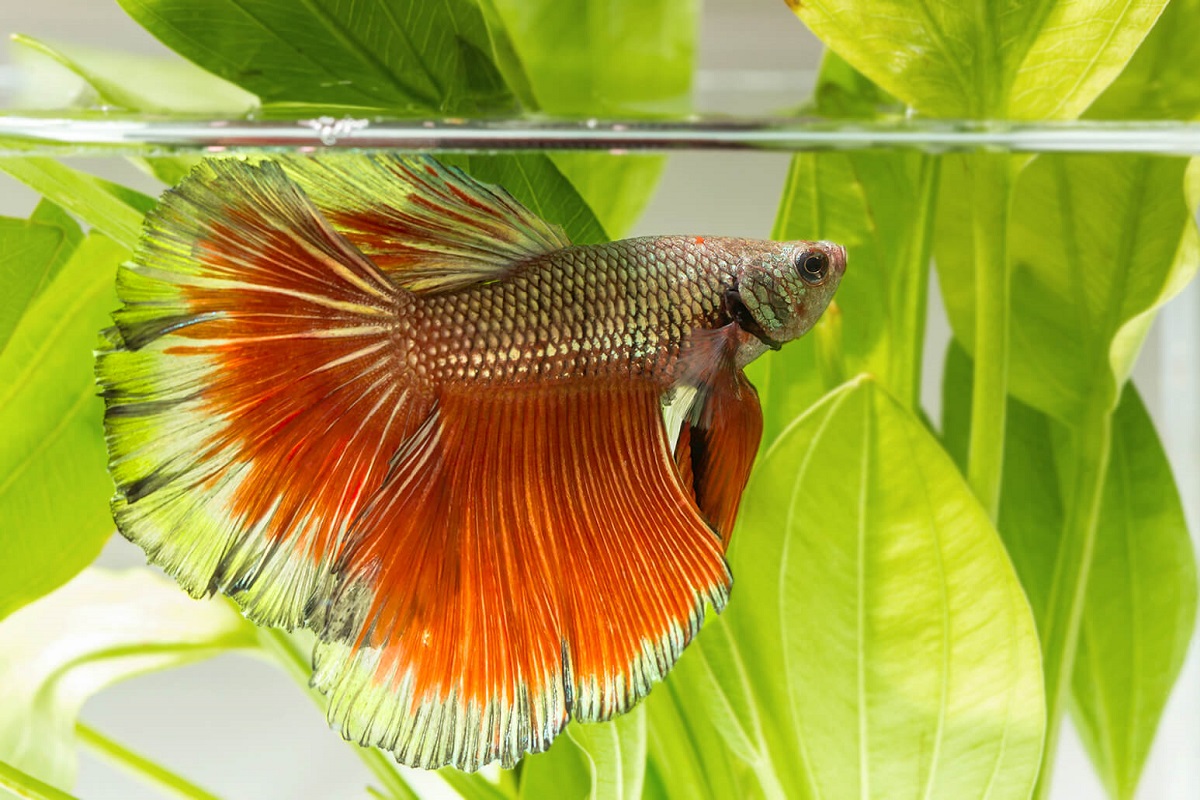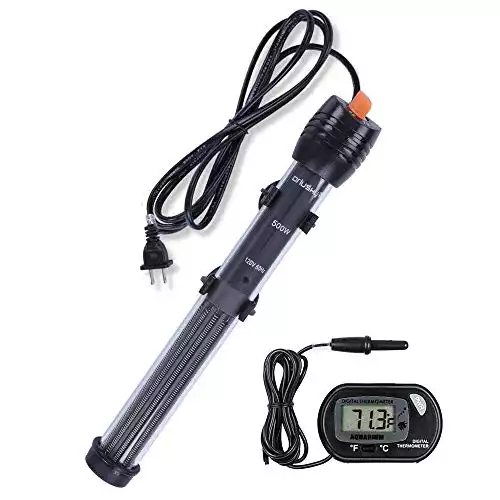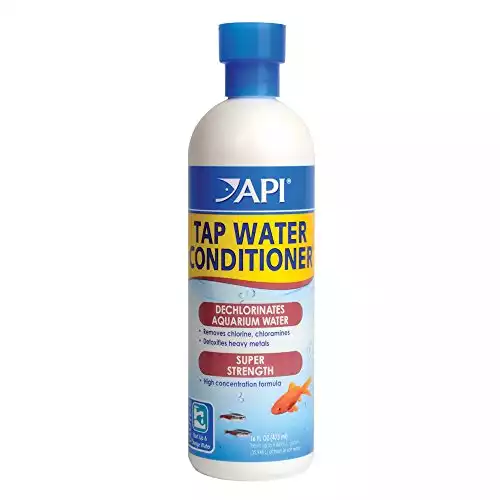Discovering your betta fish swimming in an unusual manner can be startling, a concern you might not have contemplated until witnessing it firsthand. Observing your betta struggling to maintain its buoyancy is undoubtedly distressing, as fish affected by swim bladder disease can appear severely unwell, almost as if they’re at death’s door.
Fortunately, there’s a silver lining: many instances of swim bladder disease are manageable, provided prompt action is taken.
This guide is designed to demystify swim bladder disease for you—detailing its symptoms, potential causes, and most importantly, the steps you can take to assist your betta fish in regaining its normal, graceful buoyancy.
Let’s embark on a journey to ensure your betta fish can once again swim happily and healthily. Also, I highly recommend these products to keep your betta healthy and happy throughout:
|
Best Water Conditioner
|
||
Contents
What Is Swim Bladder Disease?

Swim bladder disease is a misnomer because it isn’t a specific disease. Instead, people use this phrase when talking about any number of conditions that impact a betta fish’s swim bladder.
Many conditions can cause swim bladder disease, including:
- Shock
- Constipation
- Parasites
- Kidney cysts
- Bacterial infection
- Poor water quality
- Low water temperature
- Egg binding in females
Some of these conditions overlap. For example, shock can often happen as the result of poor water quality, which may include low water temperature.
Every betta fish has a swim bladder, an organ filled with gas that sits in the dorsal coelomic cavity. The swim bladder serves many crucial roles in your betta fish’s health, including respiration and sound production. However, its most vital function is to help the fish maintain buoyancy.
Swim bladder disease can result in over or underinflation of a betta’s swim bladder, causing them to lose the ability to remain erect.
Is Swim Bladder Disease Lethal?
Yes, in some cases, swim bladder disease is lethal in betta fish if you leave it untreated. The good news is that if you catch and treat swim bladder disease early, your betta has a good chance of recovering.
The trick is to go through a process of elimination to determine what disease or condition is causing your betta to display swim bladder disease symptoms.
Swim bladder disease symptoms vary according to the cause, so you’ll need to analyze the situation carefully to help your betta.
Symptoms of Swimming Bladder
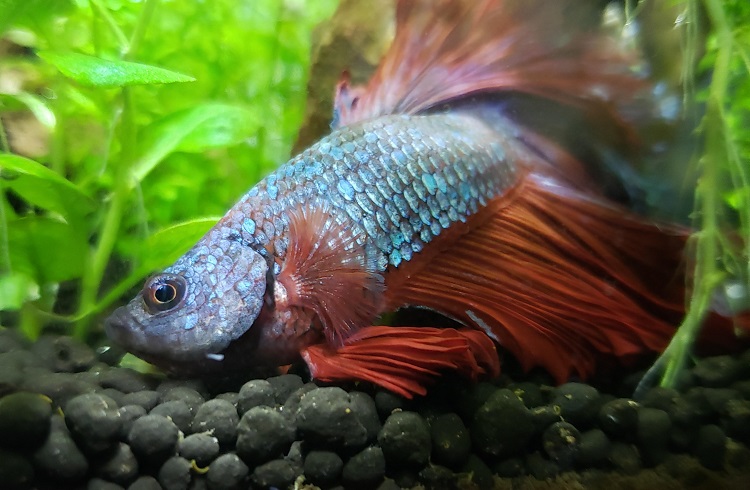
The inability to maintain proper buoyancy is the most common first sign of swimming bladder symptoms in betta fish. Your fish will likely swim on its side and may float higher or lower than usual in its tank. Scientists refer to these fish as having positive buoyancy and negative buoyancy, respectively.
Aside from the inability to maintain proper buoyancy, the symptoms of swimming bladder in betta fish often vary according to the condition or the disease causing it.
So, below are symptoms to look for in some of the most common causes of swimming bladder.
Shock
- Rapid gill movement
- Gasping for air
- Stops swimming
- Loss of color
- Lethargy (except for rapid gill movement)
Constipation
- Spitting out food
- Stringy feces
- Bloated belly
- Lethargy
- Difficulty swimming
Parasites
- Erratic swimming
- Loss of appetite
- Listlessness
- Stringy feces
- Redness
- Worms coming from tail
- Protruding scales
- Scratching
Bacterial Infection
- Lethargy
- Lack of appetite
- Clamped fins
- Loss of color
- Cloudy slime on scales
- White patches or sores
Kidney Cysts
- Abdominal swelling
- Lack of appetite
Luckily, kidney cysts aren’t common in betta fish. But if you rule out the other options here for why your betta has swimming bladder disease, they could be suffering from it.
Unfortunately, there isn’t much you can do to treat kidney cysts aside from trying to keep your fish as comfortable as possible by providing ideal water parameters for the duration of their life.
Effectively monitor and regulate your aquarium water with the best heater:
- ★300W aquarium heater is suitable for 40 to 55 gallons aquariums,Length – 11 inch,voltage 110-120V, power cord is 6ft, please choose the right wattage aquarium heater according to our size chart.
- ★It shows an area to adjust the temperature. It’s not exactly accurate but it turns easy and can be adjusted at small intervals.
- ★Explosion Proof: 2mm thickened quartz glass,can be used in fresh water and salt water aquariums,easy to hide in the tank.
Tell Me the Cause of Betta’s SBD?

The challenging part about swim bladder disease (SBD) is that many of the conditions have overlapping symptoms.
So, as we review the many causes of SBD in betta fish, it’s wise to try to make multiple changes at once instead of slowly going through a process of elimination—your betta could end up dying before you get to the root cause.
Poor Water Conditions
Betta fish are originally from shallow ponds and marshes in Asia. As a result, they require specific water parameters to stay healthy. If you don’t meet their preferred water needs, you could send your betta fish into a state of shock, inducing swim bladder disease symptoms.
Below are a betta’s preferred water conditions:
- pH: 6.5 – 7.5
- Ammonia: 0 ppm
- Nitrite: 0 ppm
- Nitrate: Less than 20 ppm
- Water temperature: 75 – 82 °F
Cold Water
We touched on the water temperature above. But since keeping the water temperature too cold is a common situation that can cause betta fish to lose proper buoyancy in their swim bladder, it’s important to home in on it further.
Cold water causes a betta fish to lose body temperature. That slows down the digestive process, forcing food to linger inside the fish’s body. As a result, the gastrointestinal tract can become blocked, straining the swim bladder.
Poor Food Quality
Digestive issues are one of the most common instigators of swim bladder disease. Unfortunately, the reason for this is often because of well-meaning betta owners that give their fish too much dry food.
The following foods increase the chances of a betta fish developing swim bladder disease:
- Flakes
- Pellets
- Freeze-dried foods
Bloodworms are a common type of freeze-dried food. While there’s nothing wrong with giving your betta fish any of these items in moderation, giving them excessive quantities can lead to SBD.
These foods have a higher chance of giving your betta swim bladder disease because they’re exceptionally dry. Therefore, they expand inside your betta’s belly, increasing the chances of intestinal blockage and constipation.
Fast Eating
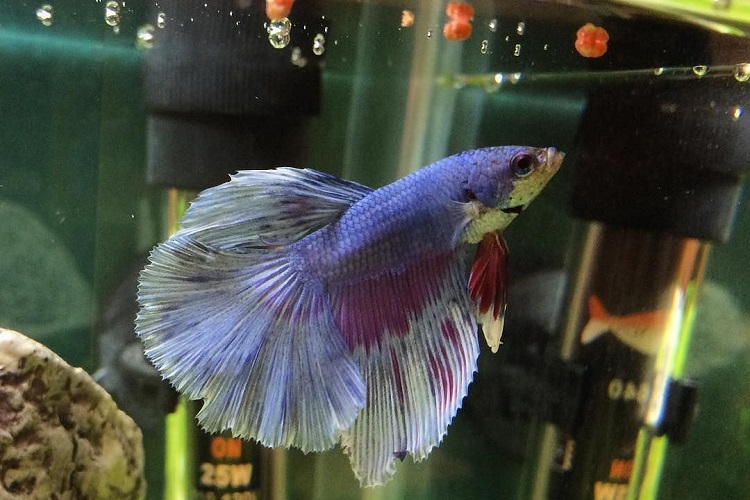
If you have a betta fish that eats you give them too quickly, no matter how high-quality their meals are, they have a higher chance of getting SBD.
The reason being is that eating too fast, which contributes to overeating, causes a betta’s stomach to expand. That leads to a painful condition where its stomach pushes into the swim bladder.
Bettas that take in a lot of air when they eat can also spark a similar situation, given that the air expands their stomach, pressing against their swim bladder.
Inherited Trait
In rare cases, betta fish may be born with their swim bladder malfunctioning. However, unless you breed and raise betta fish on your own, you likely won’t encounter this issue.
That’s because betta breeders will be able to identify a swim bladder birth issue early on in a betta fish’s life. Sadly, betta fish with swim bladder issues at birth typically die before they ever make it to a loving owner’s tank.
Infected Organs
As you’ve likely gathered by now, a betta’s swim bladder is delicate and can’t tolerate pressure. So, if your betta fish has swollen organs from an infection or other cause, the swollen organs can put pressure on the swim bladder.
A situation such as this can happen if your betta has kidney cysts or if females have an egg binding condition.
Physical Injury
Physical harm to the swim bladder can also cause your betta to display symptoms of SBD. No matter how careful you are about arranging your betta’s tank so that they have safe toys, filters, and plants, injuries can happen if you keep other fish in the tank.
Betta fish are notorious for fighting, and experts recommend that they should be kept in a tank by themselves. So, if other fish live in your betta’s tank, there’s a possibility your betta’s swim bladder could become injured from a fish fight.
Parasites
If you introduce a new plant or fish to your betta’s tank, they may carry parasites. Some of the most common types of betta parasites include:
- Tapeworms
- Roundworms
- Flatworms
Each of these parasites comes with its own symptoms, and not all of them cause SBD.
Nevertheless, many parts of a betta’s small body interconnect. So, a symptom of parasitic infections can be causing the swim bladder to malfunction.
I highly recommend this water conditioner to neutralize water toxins and keep your aquarium safe and healthy:
- Contains one (1) API TAP WATER CONDITIONER Aquarium Water Conditioner 16-Ounce Bottle
- Neutralizes chlorine, chloramines and other chemicals to make tap water safe for fish
- Prevents tap water chemicals from causing gill destruction, tissue irritation and fish death
How to Treat Swim Bladder Disease?

Your approach to treating swim bladder disease will depend on the cause of your betta’s condition. Hopefully, you now have an idea of what’s causing their condition.
But if not, know that you can’t go wrong by ensuring your betta tank has the proper water parameters and isolating your fish, should they have tank mates.
Below are the strategies you can use to treat swim bladder disease for two broad categories.
Constipation and Other Gastrointestinal Issues
If you suspect that your betta fish has a case of constipation or gastrointestinal stress, this is good news—treating it is relatively simple.
It may seem cruel, but the first step you should take is to put your betta fish on a three-day fast. That way, the food stuck inside its body will have time to work its way out. You should also gradually raise the water temperature close to 82 °F if it’s on the cooler end of the spectrum.
That’s because warmer water increases a betta fish’s metabolism, helping them pass food through their system more easily. But here’s the catch—water that’s too warm over long periods can harm your betta in a different way, given that an increased long-term metabolism causes them to age quicker.
Once your betta completes their fast, it’s safe to start feeding them a diet of daphnia or blanched, skinned peas. These foods are excellent for digestion. And since they contain water and fiber, there’s a reduced chance of them becoming stuck inside your betta’s digestive tract again.
After a few days on this special diet, you can start giving your betta fish limited amounts of dry pellets and flakes. Just make sure not to go overboard; that’s likely how your betta developed their swim bladder disease issue in the first place.
Parasitic or Bacterial Infections
If you suspect your betta fish has a parasite or bacterial infection, it’s best to put them in a quarantine tank if they have tank mates. Then, the first thing to do is check that the water meets all of a betta’s preferred parameters, paying particular attention to keeping the water temperature on the high end.
Take photos of your betta fish and show them to your local pet store owner. They might be able to identify the type of parasite your betta fish has if a parasite is an issue.
If not, they’ll likely offer you an antibiotic that covers many conditions, including parasitic and bacterial infections.
Follow the instructions on the antibiotic bottle, which will involve treating the water, not the fish itself. You should also change about 25% of the water each day until your betta’s condition improves, as this will help eliminate the parasite or bacteria.
Since antibiotics tend to take away dissolved oxygen from the water, using an air bubbler will ensure your betta fish gets enough dissolved oxygen.
Is Swim Bladder Disease Contagious?

Swim bladder disease may or may not be contagious, depending on what’s causing it. For example, if your betta fish has SBD from a parasite or bacterial infection, these conditions can be infectious.
However, many conditions causing swim bladder disease aren’t contagious, as it can be an issue with how or what food your fish is eating.
So, SBD resulting from gastrointestinal issues and constipation doesn’t require you to isolate your betta if they live in a tank with other fish.
Check out the best water conditioner for betta fish :
- WATER CONDITIONER: Makes tap water safe for bettas and other ornamental fish.
- REDUCES STRESS: Neutralizes harmful chlorine, chloramines, ammonia and heavy metals in aquarium water.
- FAST-ACTING: Works in seconds.
Conclusion
Betta fish have a short two to five-year lifespan. So as a loving betta owner, you understandably want to keep your betta as healthy and happy as possible to maximize its quality of life.
The good news is that while swim bladder disease is relatively common in betta fish, it’s typically easy to treat this condition as long as you catch it early.
In addition to following the suggestions discussed here, adding some aquarium salt to the water can also be helpful. Aquarium salt supports betta fish by helping them grow a protective slime coat, reducing swelling, and improving immune health.
When in doubt, you can always bring your betta fish to your local pet store to get a more professional opinion on the best treatment for their swim bladder disease.

Ian Sterling, founder of Fishlab.com, began his aquarium journey over 30 years ago, driven by a deep fascination for fish and their diverse personalities. His website, Fishlab.com, is dedicated to making fishkeeping accessible and enjoyable, offering beginner-friendly guidance, expert insights, and a community for aquarists to connect and share experiences.


